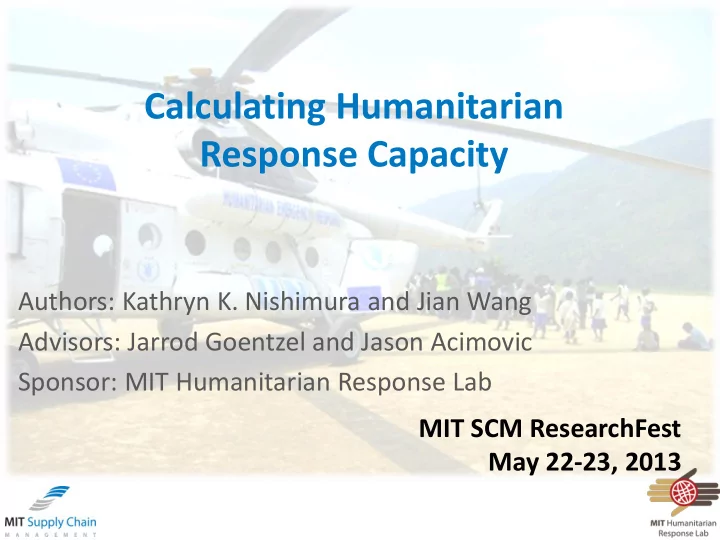

Calculating Humanitarian Response Capacity Authors: Kathryn K. Nishimura and Jian Wang Advisors: Jarrod Goentzel and Jason Acimovic Sponsor: MIT Humanitarian Response Lab MIT SCM ResearchFest May 22-23, 2013
Disaster Victims from 2003 to 2012 300 250 200 TAP (in millions) 150 100 50 - 2003 2004 2005 2006 2007 2008 2009 2010 2011 2012 Total Affected Population (TAP) website: www.emdat.be May 22-23, 2013 MIT SCM ResearchFest 2
UNHRD Network • 5 United Nations Humanitarian Response Depots (UNHRDs) • Over 1,000 SKUs • Over 5 million emergency relief items • Stockpiles owned by over 50 humanitarian organizations May 22-23, 2013 MIT SCM ResearchFest 3
Disaster Response • Phases Initial Preparedness Restoration Rebuilding Response • Deployment of humanitarian relief items to TAPs • Food and cooking supplies • Water and water purification equipment • Sanitation equipment • Shelter and blankets • Medical supplies • Etc. May 22-23, 2013 MIT SCM ResearchFest 4
Research Objectives • Build a model to minimize response times • Prescribe where items should be placed • Evaluate the inventory capacity to respond to a typical disaster UNHRD stockpiles can serve what expected percentage of people affected by a large disaster? What is the expected time to deploy a certain type of relief item? (Photos: wfp.org) May 22-23, 2013 MIT SCM ResearchFest 5
Agenda • Background on humanitarian response • Research objectives • Development of LP model and datasets • Results • Insights • Q&A May 22-23, 2013 MIT SCM ResearchFest 6
Stochastic LP Model • Objective • Minimize the average expected delivery time to deploy emergency relief items to meet a disaster’s initial needs 𝑙 × 𝑑 𝑗𝑘 𝑞 𝑙 min 𝑦 𝑗𝑘 𝑦 𝑙 𝑗,𝑘 x ij : inventory to be deployed from depot, i, to disaster site, j c ij : delivery time between depot, i, and disaster site, j p k : probability of disaster scenario, k, occurring May 22-23, 2013 MIT SCM ResearchFest 7
Dataset #1: Demand website: www.emdat.be • Filtered disaster records from 2008 to 2012 • Includes natural and manmade disasters • Does not include epidemics, industrial accidents • Size • 852 demand scenarios – TAP and location May 22-23, 2013 MIT SCM ResearchFest 8
Dataset #2: Delivery Times • Classified disasters into EM- DAT’s 23 disaster sub -regions • Measured 115 (5x23) “as -the-crow- flies” arcs • Converted distances to times, assuming 500 mph • Example: Accra to the Caribbean 5,225 miles =10.4 hours May 22-23, 2013 MIT SCM ResearchFest 9
Dataset #3: Supply Item • Blankets • Buckets • Jerry cans • Kitchen sets Example: Blanket Conversion (2 per family of 5) • Latrine plates • 164,624 units in inventory • Mosquito nets • 411,560 units of capita inventory (CI) • Soap bars website: www.hrdlab.eu May 22-23, 2013 MIT SCM ResearchFest 10
Applying the Model • Understand how CI affects the optimal pre-positioning of inventory • Keep demand scenarios and delivery times constant • Change initial CI from one to over 25 million units • See which depots the model uses and assess why • Measure the expected response capacity of the 7 selected UNHRD items • Percentage of people the item serves • Time to deliver the items May 22-23, 2013 MIT SCM ResearchFest 11
CI and Optimal Distribution 100% 90% Pre-Positioned Levels (CI units) 80% 70% 60% 50% 40% 30% 20% 10% 0% Capita Inventory Dubai, UAE Brindisi, Italy Subang, Malaysia Panama City, Panama Accra, Ghana May 22-23, 2013 MIT SCM ResearchFest 12
CI and Response Capacity 10 100% 9 90% Expected People Served (%) 8 80% Time to Respond (Hours) 7 70% 6 60% 5 50% 4 40% 3 30% 2 20% 1 10% 0 0% 1 10 100 1,000 10,000 100,000 1,000,000 10,000,000 Capita Inventory Average Time To Respond People Served May 22-23, 2013 MIT SCM ResearchFest 13
Example: Response Capacity of Blankets Expected Delivery Re- Capita Inv 0 Expected People Item Time (Hours) Allocation Served (%) Status Quo Optimal (%) Blankets 411,561 41% 8.9 7.2 23% 450,000 400,000 350,000 Capita Inventory (CI) 300,000 250,000 200,000 150,000 100,000 50,000 0 Status Quo Optimal Dubai, UAE Brindisi, Italy Subang, Malaysia Panama City, Panama Accra, Ghana May 22-23, 2013 MIT SCM ResearchFest 14
Stockpile Evaluation Expected Delivery Re- Capita Inv 0 Expected People Item Time (Hours) Allocation Served (%) (%) Status Quo Optimal Blankets 411,561 41% 8.9 7.2 23% Buckets 196,570 27% 9.1 7.8 17% Jerry Cans 391,389 40% 8.4 7.2 16% Kitchen Sets 125,030 21% 9.2 8.0 15% Latrine Plates 297,000 35% 9.1 7.5 22% Mosquito 269,863 33% 8.3 7.5 10% Nets Soap Bars 25,240 7% 9.3 8.6 8% May 22-23, 2013 MIT SCM ResearchFest 15
Insights • Depot importance • Optimal number • Order of usage • Ideal response capacity • Diminishing marginal returns at different CI levels • Inventory capacity • 8-23% potential time savings “We must, and we can, do better to be more predictable in our response to vulnerable populations around the globe 1 .” 1. Humanitarian Response Review, 2005 May 22-23, 2013 MIT SCM ResearchFest 16
Calculating Humanitarian Response Capacity Authors: Kathryn K. Nishimura and Jian Wang Advisors: Jarrod Goentzel and Jason Acimovic Sponsor: MIT Humanitarian Response Lab MIT SCM ResearchFest May 22-23, 2013
Recommend
More recommend